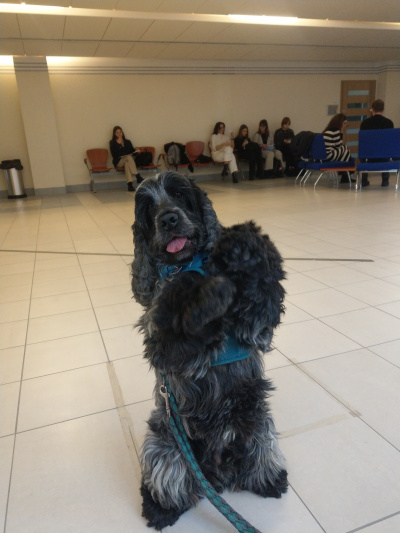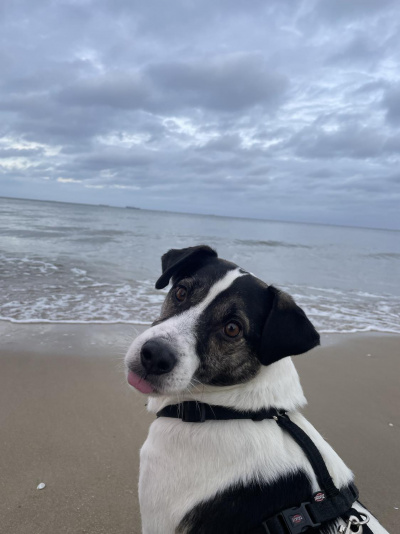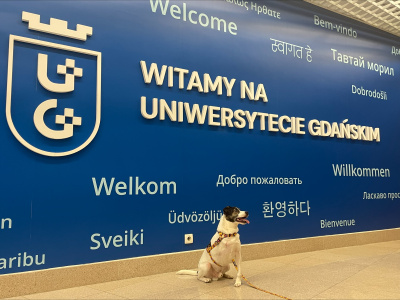
There is a ban on bringing dogs on faculty premises, but what would happen if it was lifted? This was investigated by researchers dr Magdalena Gajewska, dr Natalia Treder-Rochna and dr Magdalena Żadkowska. A pilot study 'Dog at WNS' took place at the Faculty of Social Sciences. Twenty-one students and faculty took part, bringing their charges to work and class in January.
- There has surely been a day for every dog owner when they needed to come to work with their pet. Some companies make this possible for their employees. Our project aimed to test how such a solution would work in a university environment, explains one of the coordinators of the campaign, dr Magdalena Gajewska.
The January pilot provided 30 places: 20 for students and 10 for staff. Before the start of the project, all places were filled, but in the end, 21 people decided to bring a dog. Each of them was able to take their pet to work or class for a month as required.
Safety first

Planning a dog's visit to the department was done with due diligence, especially if the pet was to take part in a class. Firstly, pilot participants had to fit into a schedule of visits to ensure that his or her charge would not meet another barking visitor to the department. ‘For behavioural reasons, moving to a new environment and meeting another dog in it could trigger aggression,’ explains dr Magdalena Gajewska.
Participants also had to consult the animal's participation with students and the lecturer. If even one of these people had protested, due to, among other things, an allergic reaction or fear of the dog, the animal's visit to the class could not have taken place. The class was also observed by zoologists to ensure the safety of the charge.
‘I emailed all my students whether they consented to the presence of a dog during the exercise. I later still confirmed their decision during the class,’ says Stefan Biedronka, a doctoral student from the Institute of Sociology. ‘I brought my dog to the university four times. I evaluate the classes positively. The dog did well. The students, when going to the toilet, sometimes interacted with her in some way. She would lie down by the benches and everyone was clearly happy.’
During the pilot, the responsibility for the dog's behaviour rested with its owner. The animal could not disturb anyone and had to allow the activities to take place. ‘Some of those interested knew in advance that their dog would not find its way in such a situation and decided not to participate in the pilot,’ explains pilot coordinator dr Magdalena Żadkowska.
‘The project introduced a lot of positive emotions among those who took part,’ adds pilot coordinator dr Natalia Treder-Rochna from the UG Institute of Psychology.
How does the presence of the dog change the mood in the classes?
‘We encountered the most criticism on social media and in our email inbox. Concerns were raised that we would turn the department into a dog run, exposing allergy sufferers to discomfort and dogs to stress causing them to behave aggressively. There were proposals to bring horses or Pharaoh ants into the department. This view was not shared by anyone who had direct contact with the action, nor by those who were familiar with the results of research on the positive effects of the presence of other non-human creatures on the well-being of people, especially young people,’ explains dr Magdalena Gajewska.
Participants have noticed that the presence of a dog in the classroom strongly improves the mood and atmosphere. Talking about non-academic topics allowed students and lecturers to step out of their roles and integrate better. The coordinators of the pilot emphasise that the impact of the dog on the class also depends on the personality of the animal. Not every dog wants to be the centre of attention.
‘A student came to my classes with her dog. I have had the most positive impressions,' says Julia Balcerowska, a doctoral student from the Institute of Psychology. ‘From the perspective of the lecturer, one might have feared that the dog would be a distraction. On the other hand, neither I nor the students felt that the extra member of the class distracted others in any way. The dog itself behaved very calmly. He could not be heard at all, and as he was quite small, he was hardly visible either.’
From the coordinators' observations, the dogs attracted the most attention at the beginning of the class. While the presence of the animal in the class was something new for the tutor and the students, both parties quickly got used to the situation. ‘The interest passed after several minutes. Probably the longer it is possible to bring dogs to the university, the less they will attract the attention of class participants,’ suggests dr Magdalena Gajewska.
The pilot took place in January, at the end of the winter term 2023/24, so there were situations in which the lecturer's dog accompanied students to exams. ‘The students asked for Betty to come to the exam. Betty is a very open creature who enjoys contact with people. During the exam, they stroked Betty and smiled at her behaviour, which made the exam less stressful,’ says dr Magdalena Gajewska.
It is worth noting, however, that this is a case where it was the lecturer who brought the dog to the exam. The researchers predict that the student bringing the animal could have the opposite effect. ‘The students feared that they would be stressed about the exam and the stress of caring for the dog would add to this. It is also unclear whether our stress would then be passed on to the animal,’ explains dr Natalia Treder-Rochna.
Will there still be a chance to bring your dog to the UG?
At the end of the study, the researchers want to make a recommendation to the UG authorities regarding the organisation of dog visits to the university. Based on the results of the questionnaires completed by the participants, the researchers are inclined to give a positive assessment of the pilot project.
‘Bringing a dog by a member of the scientific or administrative staff to their office has an incredible number of advantages. The issue is more complicated when it comes to the participation of a dog in the classroom. There is a need for quite several safeguarding mechanisms and the consent of the class participants. However, if the established conditions are met, it would be worthwhile to allow such situations as well,’ says dr Magdalena Żadkowska. ‘That is why, after the pilot conducted in January and February 2024, we recommend that UG take up the challenge of opening the campus to dogs that accompany members and members of our academic community in their daily lives. However, it will be necessary to adopt common principles, which we will establish with the University authorities in the coming months. These will include jointly developed procedures, probably separate for students and working people depending on whether they have teaching, research or administrative duties - that is, what and how many spaces they use. We think that each dog handler should familiarise themselves with training material prepared by a zoopsychologist, e.g. in the form of an online training course. In addition to the rules, the space will also have to change - we will have to delineate dog-friendly and dog-unfriendly spaces in the area. Most importantly, we see a willingness to change and an openness to new solutions, as well as a sensitivity to the perspective of canine companions.’
The 'Dog at WNS' pilot is part of the interdisciplinary research project 'Couple and Dog. Relationships and interspecies bonds in private life and public space', led by dr Magdalena Gajewska as part of the WNS Dean's grant. According to the researchers' findings, interspecies bonds are very important in the modern world, and even more so in the lives of young people.
‘The project that came to us under the WNS Grants was simply well-prepared and very interesting in terms of content. The people organising this research made sure that nobody got hurt,’ says prof. dr hab. Michał Harciarek, Dean of the Faculty of Social Sciences, about the initiative. ‘In our faculty, issues of human-human, but also human-animal relations in the context of social functioning are very important.’
While this is the end of the 'Dog at WNS' campaign for the moment, the project 'Couple and Dog: Relationships and...' is still ongoing. All childfree couples with their dogs are encouraged to participate in the study, which takes place on Tuesdays between 5 and 7 p.m. Couples interested in taking part in the study are asked to fill in the form.

- Z największą krytyką spotkałyśmy się w mediach społecznościowych i naszej skrzynce mailowej. Pojawiły się obawy, że zamienimy wydział w wybieg dla psów, narażając osoby z alergią na dyskomfort, a psy na stres powodujący u nich agresywne zachowania. Padały propozycje, by zabierać na wydział konie albo mrówki faraonki. Zdania tego nie podzielał nikt, kto miał bezpośrednią styczność z akcją, ani osoby, które znały wyniki badań mówiące o pozytywnym oddziaływaniu obecności innych nie-ludzkich stworzeń na samopoczucie ludzi, szczególnie młodych - tłumaczy dr Magdalena Gajewska.
Uczestnicy projektu zauważyli, że obecność psa na zajęciach mocno wpływa na polepszenie nastroju i atmosfery. Rozmowa na tematy pozaakademickie pozwoliła studentom oraz wykładowcy wyjść z ról i lepiej się zintegrować. Koordynatorki pilotażu podkreślają, że wpływ psa na zajęcia zależy też od osobowości zwierzęcia. Nie każdy pies chce znajdować się w centrum uwagi.
- Na moje zajęcia przyszła studentka z psem. Mam jak najbardziej pozytywne wrażenia - mówi Julia Balcerowska, doktorantka z Instytutu Psychologii. - Z perspektywy prowadzącego można by się było obawiać, że pies będzie odciągał uwagę. Natomiast zarówno ja, jak i studenci nie mieliśmy wrażenia, żeby ten dodatkowy uczestnik zajęć jakkolwiek rozpraszał innych. Sam piesek zachowywał się bardzo spokojnie. Nie było go w ogóle słychać, a że był dość mały, to prawie nie było go też widać.
Z obserwacji koordynatorek wynika, że pies przyciągał największą uwagę na początku zajęć. O ile obecność zwierzęcia na zajęciach była dla prowadzącego i studentów czymś nowym, to obie strony szybko przyzwyczaiły się do tej sytuacji. - Zainteresowanie mijało po kilkunastu minutach. Zapewne im dłużej będzie można przyprowadzać psy na uczelnię, tym mniej będą one przyciągać uwagę uczestników zajęć - sugeruje dr Magdalena Gajewska.
Pilotaż odbył się w styczniu, pod koniec semestru zimowego 2023/24, zdarzyły się zatem sytuacje, w których pies wykładowcy towarzyszył studentom na egzaminie. - Studenci poprosili, aby Betty przyszła na egzamin. Betty jest bardzo otwartą istotą, która lubi kontakt z ludźmi. W trakcie egzaminu głaskali Betty, uśmiechali się na widok jej zachowania, co sprawiło, że ten egzamin nie był tak stresujący - opowiada dr Magdalena Gajewska.
Warto jednak zauważyć, że mowa tutaj o przypadku, gdy to wykładowca przyprowadził psa na egzamin. Badaczki przewidują, że przyprowadzenie zwierzęcia przez studenta mogłoby mieć odwrotny efekt. - Studenci bali się, że będą zestresowani egzaminem, a do tego dojdzie stres opieki nad psem. Nie wiadomo też, czy w takiej sytuacji nasz stres nie udzieli się zwierzęciu - tłumaczy dr Natalia Treder-Rochna.
Czy będzie jeszcze szansa przyprowadzić psa na UG?

Na koniec badania naukowczynie chcą przekazać rekomendację władzom UG ws. organizacji pobytu psów na terenie uczelni. Na podstawie wyników ankiet wypełnionych przez uczestników akcji badaczki skłaniają się ku pozytywnej ocenie pilotażu.
- Przyprowadzenie psa przez pracownika naukowego czy administracyjnego do swojego gabinetu ma niesamowicie dużo zalet. Sprawa jest bardziej skomplikowana w przypadku uczestnictwa psa w zajęciach. Potrzeba sporej ilości mechanizmów zabezpieczających i zgody uczestników zajęć. Jednak, jeśli będą spełnione ustalone warunki, warto by umożliwić też takie sytuacje. - mówi dr Magdalena Żadkowska. - Dlatego po pilotażu przeprowadzonym w styczniu i lutym 2024 r. rekomendujemy podjęcie się przez UG wyzwania otwarcia kampusu dla psów, które towarzyszą w życiu codziennym członkom i członkiniom naszej społeczności akademickiej. Konieczne będzie jednak przyjęcie wspólnych zasad, które w najbliższych miesiącach ustalać będziemy z władzami Uczelni. Należeć do nich będą wspólnie wypracowane procedury, prawdopodobnie osobne dla osób studiujących i osób pracujących w zależności od tego, czy pełnią obowiązki dydaktyczne, badawcze czy administracyjne - czyli od tego, z jakich i ilu przestrzeni korzystają. Myślimy, że każdy z psich opiekunów powinien zapoznać się z materiałem szkoleniowym przygotowanym przez zoopsychologa, np. w formie szkolenia on-line. Oprócz zasad zmienić będzie musiała się też przestrzeń - będziemy musieli wytyczyć w niej miejsca dla psów przyjazne i takie, w których nie będą mogły one przebywać. Najważniejsze, że widzimy chęć zmian i otwartość na nowe rozwiązania, a także wrażliwość na perspektywę psich towarzyszy.
Pilotaż „Pies na WNS” jest częścią interdyscyplinarnego projektu badawczego „Para i Pies. Relacje i więzi międzygatunkowe w życiu prywatnym i przestrzeni publicznej”, kierowanego przez dr Magdalenę Gajewską w ramach grantu Dziekana WNS. Zgodnie z rozpoznaniem badaczy więzi międzygatunkowe są bardzo ważne we współczesnym świecie, a już szczególnie istotne w życiu młodych ludzi.
- Projekt, który wpłynął do nas w ramach Grantów WNS, był po prostu dobrze przygotowany i bardzo ciekawy pod względem merytorycznym. Osoby organizujące te badania zadbały, aby się nikomu nic nie stało - mówi o inicjatywie Dziekan Wydziału Nauk Społecznych prof. dr hab. Michał Harciarek. - Na naszym wydziale kwestie relacji człowieka z człowiekiem, ale także człowieka ze zwierzęciem w kontekście funkcjonowania społecznego są bardzo ważne.
O ile na ten moment to koniec akcji „Pies na WNS”, nadal trwa projekt „Para i Pies: Relacje i więzi…”. Zachęcamy wszystkie bezdzietne pary wraz z psami do udziału w badaniach, które odbywają się we wtorki w godzinach 17-19. Pary zainteresowane wzięciem udziału w badaniu proszone są o wypełnienie formularza.
